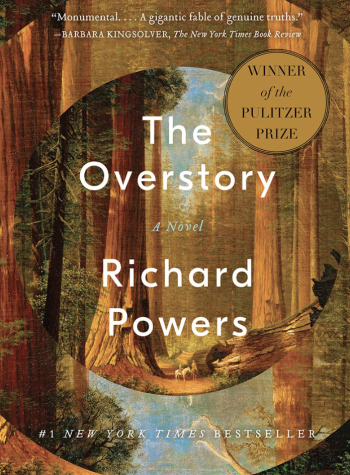BOOK CLUB: ‘The Overstory’ is a love letter to the natural world
The Seahawk’s April book club pick “The Overstory” is a read that will leave you looking at the natural world in wonder. If you are interested in works that transcend the traditional story format, “The Overstory” is for you. A masterful, branching work of fiction, this environmentalist narrative breaks the mold by giving trees the spotlight.
Richard Powers is the author of thirteen novels, his most recent title, “Bewilderment,” released three years after “The Overstory.” It seems “The Overstory” laid the thematic groundwork for “Bewilderment” in its environmentalist focus. Published in 2018, “The Overstory” won a name for itself as a New York Times bestseller and a Man Booker Prize competitor. It received the Pulitzer Prize in Fiction in 2019, one of the highest honors in the literary world. The novel continues to attract readers three years later, as its relevance only grows with every passing year.
“The Overstory” is a branching tale that weaves the lives of nine characters together with one common thread—trees. Its four sections—roots, trunk, crown, seeds—not only tie into the subject matter but artfully hint at the plot progression, allowing the novel to mimic its subject. Throughout the course of the novel, Nick, Mimi, Adam, Douglas and Olivia’s lives intersect directly as they join the fight to save dwindling forests. Ray and Dorothy’s tumultuous marriage ultimately slows into contentment as they learn to see the plants in their own backyard. Neelay’s revelation in college leads him on a journey to create a video game that points to the beauty of nature. And at the center of it all, Patricia’s discoveries about trees lends her the affluence to affect the other eight through her writing on the subject.
It is a slow-growing plot, just like the trees the novel speaks of. Boasting 500 pages, this is a book structured to be consumed slowly and thoughtfully. Powers introduces each character in the context of their relationship with trees, and the plot unfolds from there as reverence for the natural world grows in their life. It is an extremely focused novel in this way, demanding from the reader a respect for its subject as the same quality grows in its characters. However, just like real trees, the ways in which each character comes to that respect differ wildly.
This diversity among characters is one of the novel’s foremost strengths. This is not only in the psychosocial forces that affect their upbringing, but their encounter with trees as well. For all of the characters except Olivia, there is no singular turning point that begins their journey with the natural world. Powers demonstrates that it is indeed a journey, often taking many turns to arrive at the destination of full appreciation. For example, while Nick’s fascination begins with the generations-long flipbook documenting the growth of their family chestnut, it is not until Olivia arrives, claiming to commune with spirits of trees, that he joins her to protest mass deforestation. By gradually increasing the importance of trees in each character’s lives, Powers allows each of them to form a real connection with the natural world. The natural progression gives their developing passions a sense of realness that is necessary for this book.

Powers also makes an excellent choice in varying the scale of action in each of their lives. While Douglas’ quick-growing love for trees and wandering lifestyle motivate him to join the environmentalist movement, Ray and Dorothy’s tumultuous marriage distracts them from the natural world until Ray’s stroke slows their lifestyle. There is a world of difference between their paths, but that is the genius of Powers. Through this variety, he emphasizes that anyone is capable of involvement. By encompassing such a wide range of experiences, Powers draws attention to the connecting factor between them—trees.
“The Overstory” conveys an unmistakable reverence for its subject. Throughout the novel, Powers utilizes diverse tree imagery that creates a wistful tone toward nature. The writing style in these moments is unlike many modern novels, diving into long and poetic descriptions that many writers now avoid. Each species of tree retains distinct details from one another, separating them in the reader’s mind. Their actions are often personified, as well, making their status as living things harder to deny. Even in moments not directly related to trees, Powers brings the trees around the character into the narrative as they walk by, blissfully unaware of the life they are surrounded by. These effects all further emphasize the theme. Powers takes every opportunity to stress to the reader that trees are the core tenant of this story.
Not only does Powers capture the beauty of trees, but he educates as well. Through Patricia’s storyline, readers come to understand the dynamics of a forest. She influences each of the other eight characters through her book that divulges her greatest discovery—that trees are able to communicate with each other. Through Nick, Mimi, Adam, Douglas and Olivia’s storyline, American deforestation is exposed. They spend the majority of the novel working to slow loggers, but their efforts rarely pay off. The felling of Mimas—an extremely old, technically protected tree—particularly brings the urgency of their mission to light. By providing the cause and evidence behind the environmentalist perspective, Powers builds sympathy for these five protestors.
The one drawback of the book is, at times, its density. It is likely the average reader will struggle to stay engaged. “The Overstory” differs in writing style from that traditional people-based narrative, meaning certain character actions or descriptions are sometimes not clear in relevance to the plot. However, this effect actually emphasizes the main point of the novel. Many readers will go into the novel expecting the characters to be the centerpiece, as they usually are, but Powers is careful to keep the focus on the trees. It is not a human savior story, which makes its environmentalist focus even more nuanced and beautiful. That the novel ends on a “cliffhanger” drives home the point that our world still hangs in the balance. “The Overstory” is an elegant call to action.
A novel weaving environmentalist sentiment into a beautiful story, “The Overstory” will leave you changed.











